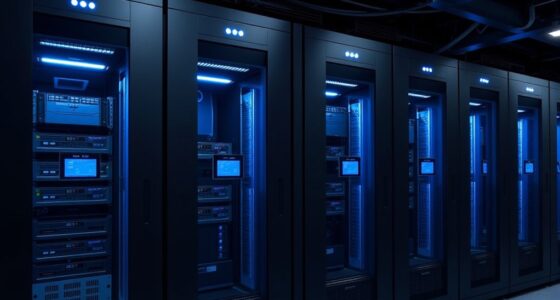If you’re looking for the 14 best dual power supply network switches in 2025, I recommend considering options like MokerLink’s high-capacity gigabit switches, industrial-grade models, and those with PoE capabilities. These switches offer redundancy, durability, and reliable connectivity for demanding environments. Features like dual power inputs, surge protection, and easy installation make them excellent choices. Keep exploring further, and you’ll discover detailed insights to help you pick the perfect switch for your needs.
Key Takeaways
- Dual power supply switches ensure high reliability and minimal downtime through automatic failover and redundant power sources.
- Rugged, industrial-grade switches with surge protection and wide temperature tolerance are ideal for harsh environments.
- Managed switches with advanced network features (VLAN, QoS, SNMP) improve performance and remote diagnostics.
- High-capacity switches with PoE support enable reliable power and data transmission for connected devices.
- Compatibility with various mounting options and external power supplies offers flexible deployment in diverse settings.
MokerLink 48 Port Gigabit Ethernet Switch
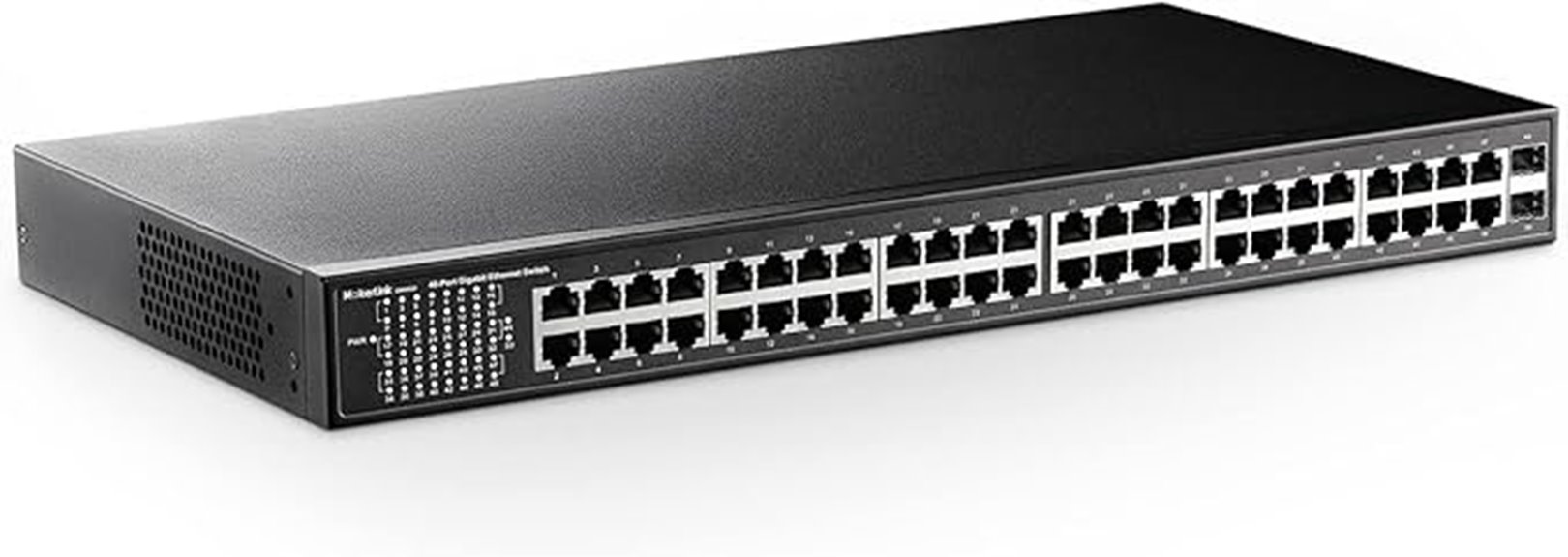
If you’re looking for a reliable, high-capacity switch for demanding network environments, the MokerLink 48 Port Gigabit Ethernet Switch is an excellent choice. It offers 48 gigabit ports plus 2 SFP ports, with a switching capacity of 112Gbps and all ports supporting 1Gbps data transfer simultaneously. Its durable metal, fanless design guarantees silent operation and long-term stability. With dual power supplies, it provides redundancy, reducing downtime. Ideal for large networks, PoE applications, and extended range scenarios, it’s a versatile, straightforward device that’s easy to set up and maintain, making it perfect for businesses and data centers.
Best For: large networks, PoE applications, and demanding environments requiring reliable, high-capacity unmanaged switches.
Pros:
- Supports 48 gigabit ports plus 2 SFP ports with 112Gbps switching capacity for high throughput
- Durable metal, fanless design ensures silent operation and long-term stability
- Dual power supplies provide redundancy, minimizing downtime
Cons:
- Lacks management interface and advanced configuration options
- Firmware updates and technical support can be limited, especially for Realtek models
- Some users report hardware issues such as sharp SFP slot edges or power supply concerns
TP-Link TL-SG105 5-Port Gigabit Ethernet Switch

The TP-Link TL-SG105 5-Port Gigabit Ethernet Switch is an ideal choice for small offices or home networks seeking reliable, plug-and-play expansion. Its durable metal casing and fanless design ensure silent operation in any environment, whether on a desk or mounted on a wall. Supporting five 10/100/1000 Mbps ports with Auto Negotiation and Auto MDI/MDIX, it simplifies networking without complex setup. The switch features energy-efficient technology, reducing power consumption while maintaining performance. With advanced QoS and IGMP Snooping, it guarantees smooth video and voice data transmission. Backed by a three-year warranty and technical support, it’s a dependable, straightforward solution for expanding network capacity.
Best For: small offices and home networks seeking a reliable, easy-to-use, plug-and-play Ethernet switch for expanding network connectivity.
Pros:
- Easy plug-and-play setup with no configuration needed
- Durable metal casing with fanless, silent operation
- Supports energy-efficient technology to reduce power consumption
Cons:
- Limited to five ports, may not suit larger network needs
- No advanced management features for network customization
- Lacks PoE (Power over Ethernet) support for powering devices
Gigabit PoE Switch, 2 Port Ethernet Switch, Network Hub, POE/PoE+ Adapter

For network professionals seeking reliable, high-speed power and data transmission, the Gigabit PoE Switch with 2 Ethernet ports offers an ideal solution. It converts non-PoE devices into PoE-enabled ones, supporting both PoE and PoE+ standards with 15.4W and 30W power options. Its plug-and-play design makes setup straightforward, extending network reach up to 328 feet using Cat5e or higher cables. The switch’s durable aluminum alloy casing and gold-plated ports guarantee signal stability and longevity. With intelligent PoE detection, it safely powers compatible devices like IP cameras and access points, enhancing network flexibility without complex configurations.
Best For: network professionals and businesses seeking a reliable, high-speed solution to expand their network connectivity and power PoE devices in remote or large-area setups.
Pros:
- Supports both PoE and PoE+ standards with 15.4W and 30W power options, ensuring compatibility with a wide range of devices.
- Plug-and-play design allows for quick, easy installation without additional software or configuration.
- Durable aluminum alloy casing and gold-plated ports ensure signal stability, longevity, and reliable performance.
Cons:
- Does not include an external power adapter, requiring PoE input or an external power supply for operation.
- Limited to 2 Ethernet ports, which may not suffice for larger network expansion needs.
- Maximum cable length supported is 328 feet, which might be limiting for extremely large installations.
MokerLink 10 Port Gigabit Industrial DIN-Rail Ethernet Switch

Designed with industrial environments in mind, the MokerLink 10 Port Gigabit Industrial DIN-Rail Ethernet Switch stands out thanks to its dual power supply support, ensuring uninterrupted operation even during power failures or fluctuations. Its rugged aluminum shell, IP40 rating, and wide temperature range make it highly durable in harsh conditions. The switch features 10 gigabit ports, supporting auto-negotiation and PoE up to 30W per port. Its plug-and-play setup, compact size, and DIN-rail mounting make deployment easy. While lacking advanced management features, its robust build and dual power support make it reliable for small industrial and security networks.
Best For: small industrial, security, or IoT networks needing rugged, reliable Ethernet switching with PoE capabilities.
Pros:
- Durable industrial-grade construction with aluminum shell and wide temperature range (-40°C to 75°C).
- Supports dual power supplies with automatic fault switching for increased reliability.
- Plug-and-play design with 10 gigabit ports and PoE support up to 30W per port, ideal for IP cameras and small access points.
Cons:
- Limited management features; no VLAN, smart routing, or advanced network configuration.
- Some units have experienced failures such as port malfunction or power supply issues, especially during storms.
- Only 10 ports, which may be insufficient for larger or more complex networks.
MT-VIKI 48V POE Ethernet Splitter (No Power Supply)
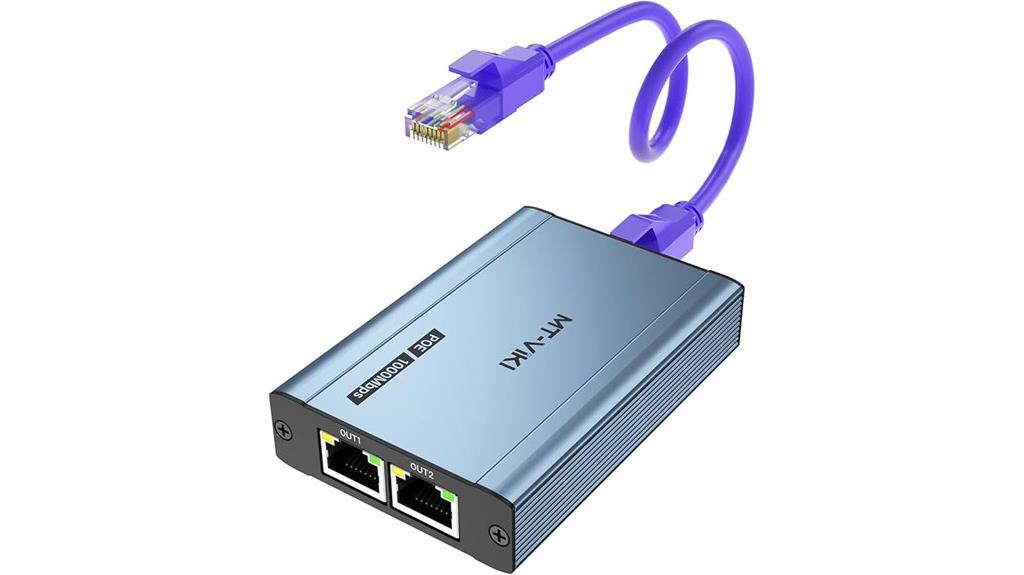
If you’re expanding a network with POE devices like cameras or speakers, the MT-VIKI 48V POE Ethernet Splitter offers a straightforward solution by eliminating the need for an external power supply when connected to a POE switch. It supports gigabit speeds up to 1000 Mbps over long distances, up to 200 meters. Designed for seamless integration, it delivers 60W of power via POE or DC power, depending on your setup. You can cascade multiple units for larger networks, just ensuring the last has a 48V power adapter. This versatile splitter simplifies installation, reduces clutter, and maintains reliable, high-speed data and power delivery.
Best For: those looking to expand their POE network with high-speed, long-distance Ethernet connections without the need for additional power supplies.
Pros:
- Supports gigabit Ethernet speeds up to 1000 Mbps over distances up to 200 meters.
- No external power supply needed when connected to POE switches, simplifying installation.
- Compatible with multiple cable types (Cat5e, Cat6, Cat7, Cat8) and supports cascading for larger networks.
Cons:
- Requires a 48V power adapter for the last unit in a cascade if not connected directly to a POE switch.
- Not suitable for non-POE devices unless paired with a compatible power supply.
- Limited to 60W power output, which may not be sufficient for high-power devices.
Industrial 8-Port Gigabit POE+ Switch with DIN-Rail Power Supply
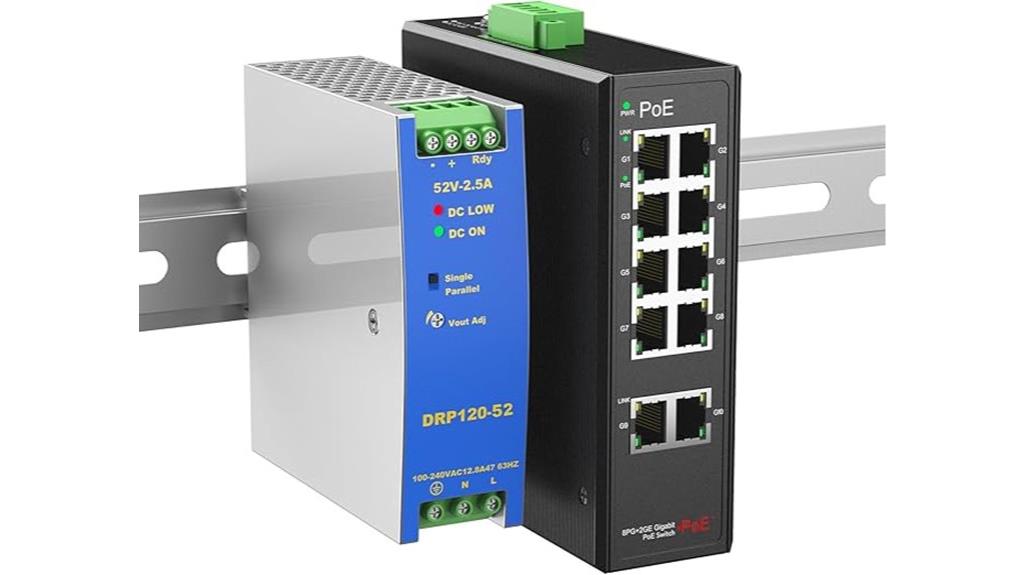
The Industrial 8-Port Gigabit PoE+ Switch with DIN-Rail Power Supply stands out for its robust power management and ease of installation, making it an ideal choice for environments that demand reliable and continuous operation. Its industrial-grade aluminum housing with IP40 protection guarantees durability in harsh conditions, while DIN-rail mounting simplifies setup. Supporting 8 PoE ports with up to 30W per port and a total 120W power budget, it powers devices like IP cameras and VoIP phones efficiently. With a 20Gbps capacity, auto-negotiation, plug-and-play design, and no external power needed, it offers seamless, reliable connectivity in demanding industrial settings.
Best For: Industrial and commercial environments requiring reliable, high-power PoE connectivity in harsh conditions such as factories, data centers, and outdoor surveillance setups.
Pros:
- Robust industrial-grade aluminum alloy housing with IP40 rating for durability
- Supports up to 30W per port with a total power budget of 120W, suitable for high-power devices
- Easy DIN-Rail mounting and plug-and-play setup for quick deployment and maintenance
Cons:
- Does not support passive 24V PoE or rack mounting, limiting some integration options
- Limited to 8 PoE ports without additional expansion capabilities
- Some features like VLAN and extend functions are unclear or may require further configuration
TP-Link 8-Port Gigabit Ethernet Network Switch

The TP-Link 8-Port Gigabit Ethernet Network Switch stands out for users who need reliable, high-speed connectivity with easy setup and robust build quality. Its metal casing guarantees durability, heat dissipation, and EMI protection, making it more resilient than plastic alternatives. The fanless design assures silent operation and longer lifespan. With 8 gigabit ports supporting auto negotiation and MDI/MDIX, setup is straightforward—plug and play, no software needed. It also features energy-efficient technology to save power, along with traffic management tools like flow control and loop prevention. Overall, it’s a solid choice for expanding networks that demand stability, speed, and ease of use.
Best For: small to medium-sized offices or home offices seeking reliable, high-speed wired network expansion with easy setup and durable build quality.
Pros:
- Durable metal casing provides enhanced heat dissipation and EMI protection.
- Plug and play design allows for quick, easy installation without software setup.
- Supports advanced traffic management features like QoS and IGMP Snooping for stable data transmission.
Cons:
- No built-in Wi-Fi or wireless capabilities; requires wired connections only.
- Lacks advanced management features found in more complex switches.
- Fixed ports may limit scalability compared to modular solutions.
Industrial Ethernet Switch, 6-Port Gigabit Switch

Designed for industrial environments where uninterrupted network connectivity matters, this 6-port Gigabit Ethernet switch features dual power inputs with auto-failover, guaranteeing continuous operation even if one power source fails. It offers 4 Gigabit Ethernet ports, an RJ45 uplink, and an SFP port, with a 12Gbps switching capacity. Built to withstand extreme temperatures from -40°C to 85°C and equipped with IP40 protection and lightning resistance, it’s rugged and reliable. Its fanless design ensures silent operation, while mounting options via DIN rail or wall make deployment flexible. Internal UL-certified power supplies simplify setup, making it ideal for control panels, factories, and outdoor industrial applications.
Best For: industrial environments requiring reliable, rugged network connectivity with PoE support and easy installation for control systems, factories, and outdoor applications.
Pros:
- Rugged design with extreme temperature tolerance (-40°C to 85°C) and IP40 protection for harsh environments
- Dual power inputs with auto-failover and reverse polarity protection ensure continuous operation
- Plug-and-play installation with internal UL-certified power supply and fanless, silent operation
Cons:
- Limited to 10/100 Mbps speeds, not gigabit, which may restrict high-bandwidth data transfer
- Short hardwired power cord may require additional extension or power management solutions
- Minimal documentation and lack of extensive online support could pose challenges for troubleshooting
TP-Link TL-SG1005P 5-Port Gigabit PoE Switch
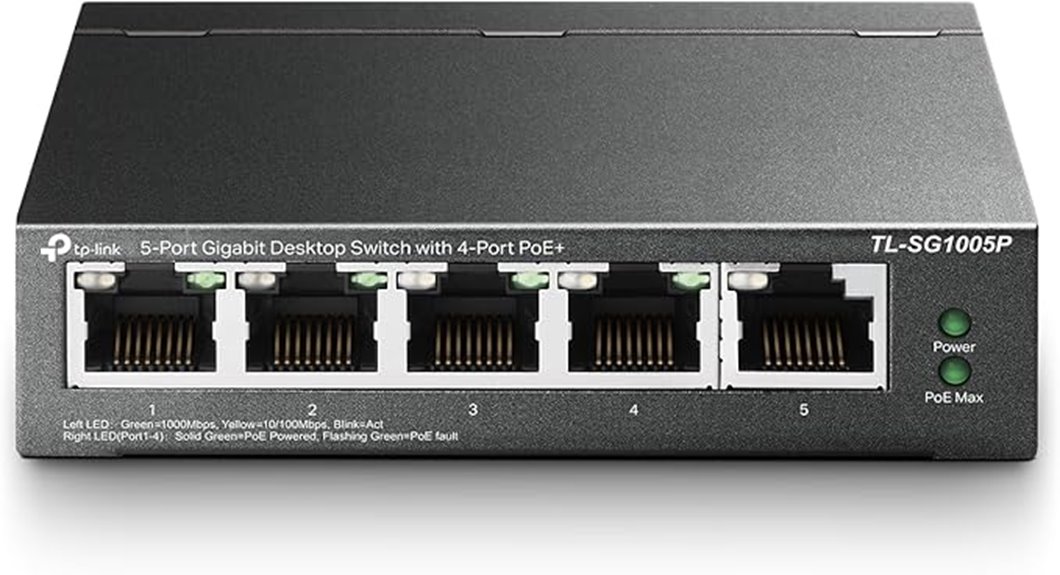
If you’re looking for a reliable switch to power your PoE devices efficiently, the TP-Link TL-SG1005P offers a compelling solution with its 4 PoE+ ports supporting up to 30W each. It features a total PoE power budget of 65W and includes a non-PoE Gigabit port for high-speed data transfer. The switch’s sturdy metal case and flexible design allow for desktop or wall mounting, making it versatile for various environments. With plug-and-play setup, QoS, and IGMP Snooping, it ensures seamless, high-quality video, voice, and data transmission. Plus, its fanless, silent operation and 3-year warranty make it a reliable, low-maintenance choice.
Best For: small to medium-sized businesses or home offices seeking a reliable, easy-to-use PoE switch for powering and connecting multiple network devices efficiently.
Pros:
- Supports 4 PoE+ ports with up to 30W per port, ideal for powering multiple devices simultaneously.
- Plug-and-play setup with no software configuration required simplifies installation.
- Quiet, fanless design ensures silent operation in noise-sensitive environments.
Cons:
- Limited to 5 ports, which may not be sufficient for larger network setups.
- Total PoE power budget of 65W might restrict the number of high-power devices connected simultaneously.
- No advanced management features like VLAN or SNMP for enterprise-level control.
Industrial 3 Ports PoE Ethernet Switch with SFP Slot, Unmanaged, 10/100/1000Mbps
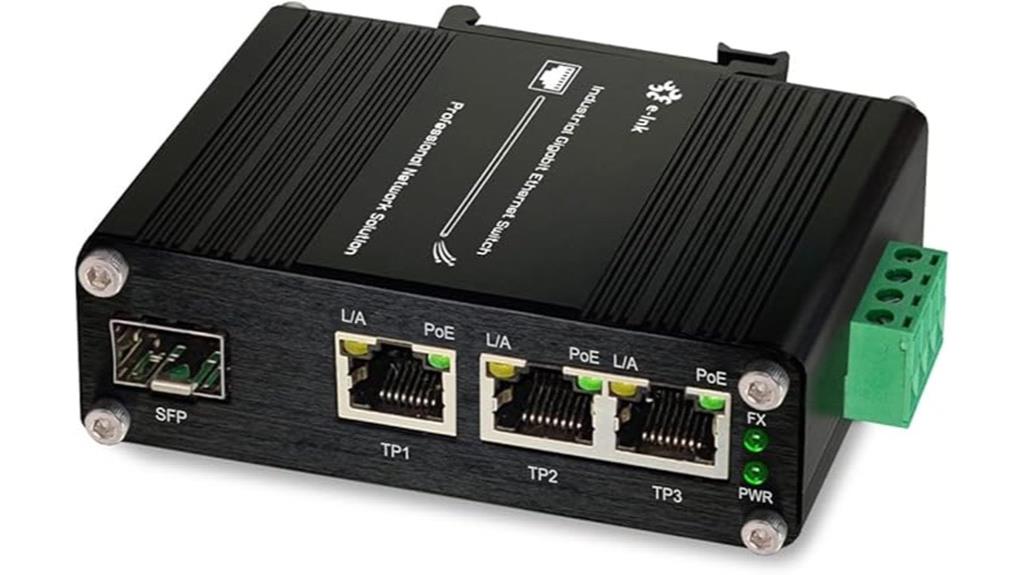
For industrial applications requiring reliable PoE connectivity, this unmanaged 3-port Ethernet switch with an SFP slot stands out thanks to its dual power input capability. It features three gigabit RJ45 ports supporting IEEE802.3af/at PoE, each delivering up to 30W, with a total capacity of 90W. The switch also includes a dual-mode SFP slot for fiber connections, supporting speeds up to 1Gbps. Built with an aluminum housing and IP40 protection, it’s designed for harsh environments, operating from 12-48V DC. Its dual power inputs guarantee continuous operation, making it ideal for outdoor security, IoT, and fiber extension projects.
Best For: industrial, outdoor, and harsh environment applications requiring reliable PoE connectivity and fiber extension capabilities.
Pros:
- Supports dual power inputs for continuous operation and increased reliability.
- Rugged aluminum housing with IP40 protection suitable for outdoor and industrial settings.
- Easy installation with both DIN rail and wall mounting options, and flexible SFP compatibility.
Cons:
- Limited to unmanaged switch functionality, which may not suit advanced network configurations.
- Some users report only 100Mbps link speeds without appropriate SFP modules, requiring compatible upgrades.
- Does not include a power supply, necessitating additional purchase for complete setup.
Gigabit POE Splitter 1 to 2, 1000Mbps Ethernet Splitter

The Yinker Gigabit POE Splitter 1 to 2 stands out as an ideal solution for professionals needing reliable network expansion without sacrificing speed. It supports full 1000Mbps data transfer, letting you connect two POE devices from a single switch effortlessly. Compatible with IP cameras, phones, and outdoor security gear, it can operate via POE or an external 48V power supply. Its cascade capability and 200-meter transmission distance make it versatile for industrial or outdoor setups. Easy to install with LED indicators, it’s lightweight and portable. Priced affordably around $28.99, it offers a cost-effective way to extend your network while maintaining high-speed, stable connections.
Best For: professionals and technicians seeking a reliable, portable solution for expanding high-speed IP security, industrial, or outdoor network setups.
Pros:
- Supports full 1000Mbps high-speed data transfer for fast, stable connections
- Compatible with POE switches, IP cameras, and outdoor security devices for versatile deployment
- Easy to install with LED indicators, lightweight, and suitable for portable use
Cons:
- External power supply not included, potentially adding extra cost
- Performance may decline when running multiple gaming PCs simultaneously despite advertised speeds
- Requires high-quality cabling for optimal performance over long distances
VCELINK 2 Port RJ45 Network Switch

The VCELINK 2 Port RJ45 Network Switch stands out as an ideal choice for users who need seamless, flexible network switching without downtime or complex setup. It offers versatile configurations, allowing connection of two networks to a single device with easy mechanical switching. The switch operates plug-and-play, requires no power, and provides physical isolation to prevent IP serial connection issues. Supporting speeds up to 1000Mbps and compatible with PoE devices, it suits various equipment like routers and surveillance systems. Its compact, durable design with indicator lights makes it simple to manage, making it perfect for quick, reliable network switching in any environment.
Best For: users seeking a reliable, easy-to-use network switch for quick switching between multiple networks or devices without complex setup or power requirements.
Pros:
- Mechanical, plug-and-play design with no power needed for operation
- Supports high-speed transmission up to 1000Mbps and is compatible with PoE devices
- Compact, durable construction with indicator lights for easy management
Cons:
- Limited to 2 ports, which may not suit larger or more complex network setups
- No advanced features such as managed switching or network security options
- Physical switching may be less suitable for environments requiring frequent or automated network changes
NETGEAR 8 Port PoE Gigabit Ethernet Switch

If you’re seeking a reliable switch to power and connect multiple devices efficiently, the NETGEAR 8 Port PoE Gigabit Ethernet Switch is an excellent choice. It offers 8 Gigabit Ethernet ports, all with PoE+ support, providing up to 62W total power for devices like IP cameras, VoIP phones, and access points. Its easy smart management software makes configuration and security straightforward, while the durable hardware and 3-year warranty guarantee long-term reliability. Plus, its flexible installation options—desktop or wall mounting—make it suitable for various environments. This switch combines power, performance, and ease of use, making it a top contender for dependable network setups in 2025.
Best For: small to medium-sized businesses or home networks needing reliable PoE power and simple management for multiple connected devices.
Pros:
- Supports 8 PoE+ ports with a total power budget of 62W, ideal for powering IP cameras, VoIP phones, and access points.
- Easy Smart Managed Essentials software provides straightforward network configuration, security, and monitoring.
- Durable hardware backed by a 3-year limited warranty ensures long-term reliability.
Cons:
- Limited to basic management features; lacks advanced networking options found in fully managed switches.
- Total power budget of 62W may be insufficient for large deployments with high-power PoE devices.
- No support for stacking or advanced redundancy features, which could limit scalability in larger setups.
EWIND 2025 5 Port Gigabit Ethernet Switch

Looking for a reliable, easy-to-set-up switch that delivers instant gigabit speeds without complicated configuration? The EWIND 2025 5 Port Gigabit Ethernet Switch is perfect. It features plug-and-play setup with auto-sensing ports supporting 10/100/1000Mbps, along with energy-efficient IEEE 802.3az. Its fanless, graphene nano-coating design ensures silent operation and better thermal management, while dual-color LEDs make port status easy to identify. Built with a durable metal chassis, it supports desktop or wall mounting, fitting seamlessly into home or office setups. Reliable and tested over years, this switch handles multiple devices smoothly, reducing installation costs and providing stable, high-speed connections effortlessly.
Best For: home users and small office setups seeking a reliable, easy-to-install gigabit Ethernet switch with energy efficiency and silent operation.
Pros:
- Plug-and-play setup with auto-sensing 10/100/1000Mbps ports for quick installation
- Fanless, graphene nano-coating design ensures silent operation and enhanced thermal management
- Durable metal chassis with multiple mounting options suitable for various environments
Cons:
- Missing power adapters in some regional packages, such as the UK
- Limited to 5 ports, which may not suffice for larger networks
- No advanced configuration options or managed switch features included
Factors to Consider When Choosing a Dual Power Supply Network Switch

When selecting a dual power supply network switch, I focus on factors like redundancy capabilities and power input options to guarantee reliability. I also consider environmental durability and installation flexibility to match the operating environment. Finally, management features play a vital role in maintaining control and efficiency.
Redundancy Capabilities
Choosing a dual power supply network switch requires careful consideration of its redundancy features to guarantee maximum reliability. I look for switches that can automatically switch to the backup power source if the primary fails, ensuring uninterrupted operation. Hot-swappable power modules are a big plus because they allow maintenance without shutting down the device, minimizing downtime. I also check for fault detection and alert systems that notify me promptly of any power issues, so I can act quickly. The ability to support automatic transfer switches and load balancing enhances overall network resilience—especially in mission-critical environments where even brief outages are costly. A switch with robust redundancy capabilities gives me confidence that my network will stay online, even when power disruptions occur.
Power Input Options
Selecting the right power input options for a dual power supply network switch is essential for ensuring dependable operation. I look for switches that support redundant power inputs, so I can connect to two separate sources for increased uptime. Diverse port types like terminal block connectors, IEC sockets, or DC barrel jacks give me flexibility to match my power arrangements. An automatic failover feature is critical—so if the primary source fails, the switch seamlessly switches to the backup, maintaining network stability. I also pay attention to features like fault detection and switching, which help prevent downtime. Proper grounding and choosing appropriate power sources are crucial to protect against surges and lightning strikes, ensuring my network remains reliable and safe.
Environmental Durability
Ensuring environmental durability in a dual power supply network switch is crucial for maintaining reliable performance in harsh conditions. I look for switches with robust IP-rated enclosures, like IP40 or higher, which resist dust, water, and mechanical impacts. Components such as industrial-grade aluminum or rugged thermoplastic housings add extra resilience, while surge protection—often 6KV lightning resistance—safeguards against electrical surges. A wide operating temperature range, typically from -40°C to 85°C, is essential for outdoor or extreme environments. These features help minimize downtime and reduce maintenance costs, ensuring continuous network operation in challenging settings. When selecting a switch, I prioritize environmental durability to guarantee it withstands harsh conditions and delivers dependable, long-term performance.
Installation Flexibility
When evaluating a dual power supply network switch for your setup, installation flexibility plays a key role in ensuring seamless integration. These switches support both rackmount and desktop configurations, accommodating various space constraints and infrastructure needs. Many models include mounting hardware like DIN rail brackets or wall-mount kits, making installation in industrial environments, control panels, or tight spaces straightforward. The dual power inputs enable placement in locations where power redundancy is critical, without needing extra power sources. Compatibility with different power sources, such as AC and DC inputs, adds to their adaptability for diverse electrical setups and backup systems. Additionally, accessible power ports and simple wiring make maintenance, upgrades, and troubleshooting easier, reducing downtime and ensuring reliable operation.
Management Features
Management features markedly enhance the functionality and reliability of dual power supply network switches. Managed switches provide advanced capabilities like VLAN setup, QoS prioritization, and SNMP monitoring, which unmanaged models lack. These features enable remote diagnostics and real-time status alerts, considerably improving troubleshooting and uptime. Port mirroring, link aggregation, and traffic analysis are typically available only on managed switches, giving better control over network performance. Additionally, management functionalities support firmware upgrades and configuration backups, ensuring security and consistency across the network. With these tools, I can monitor traffic patterns, detect faults early, and maintain a stable connection. Overall, management features are vital for fine-tuning network performance, maintaining security, and ensuring that the switch adapts to evolving network demands.
Power Budget Limits
Choosing the right dual power supply network switch involves carefully considering its power budget limit, which is the maximum wattage it can provide to connected PoE devices at once. This limit determines how many devices and what power levels the switch can support simultaneously. Overloading the switch’s capacity can lead to insufficient power delivery, causing devices like cameras or access points to reboot or malfunction. To avoid this, I recommend calculating the total power consumption of all PoE devices beforehand. Switches with higher power budgets are better suited for supporting high-power devices, ensuring reliable operation and preventing overloads. Understanding this limit helps maintain network stability and ensures every connected device receives the necessary power without risking disruption.
Price and Support
Selecting a dual power supply network switch involves more than just considering its power budget; it’s also important to evaluate its price and support options. Usually, higher-priced switches include better support, longer warranties, and more extensive technical assistance. Support quality varies—some manufacturers offer 24/7 customer service and quick response times, which are crucial for maintaining network reliability. Investing in a switch with dependable support can reduce downtime and repair costs by ensuring prompt troubleshooting and replacements. Price differences often reflect features like firmware updates, management capabilities, and compatibility with different power standards. Choosing a product with the right balance of cost and support ensures easier long-term maintenance, firmware updates, and technical guidance, ultimately helping your network stay resilient and efficient over time.
Frequently Asked Questions
How Does Dual Power Supply Enhance Network Switch Reliability?
Dual power supply enhances network switch reliability by providing a backup in case one power source fails. I’ve seen how this redundancy keeps networks running smoothly without interruptions. When one power supply glitches or loses power, the other takes over seamlessly, ensuring continuous connectivity. This setup minimizes downtime, boosts resilience, and gives me peace of mind knowing my network stays operational even during power issues.
Can Dual Power Supplies Prevent Network Downtime During Power Failure?
Think of dual power supplies as a lifeboat on a sinking ship. Yes, they can prevent network downtime during power failures by automatically switching to backup power. This seamless shift keeps your network running smoothly, even when the main source fails. I’ve seen this in action, and it’s a game-changer for maintaining reliable connectivity. So, investing in dual power supplies truly safeguards your network against unexpected outages.
What Are the Common Configurations for Dual Power Supply Switches?
I typically see dual power supply switches configured in either redundant or load-sharing setups. Redundant configurations ensure continuous operation if one power source fails, while load-sharing distributes power evenly across both supplies for efficiency. I prefer redundancy for critical networks, as it provides extra reliability. These configurations are usually set up through specific hardware settings, guaranteeing seamless failover and peak performance during power issues.
Are There Specific Certifications Required for Industrial Dual Power Switches?
Yes, industrial dual power switches often need certifications like UL, IEC, or CE to guarantee safety and compliance. These certifications verify that the device meets rigorous standards for electrical safety, quality, and environmental factors. I always check for these certifications before selecting a switch, especially for critical industrial applications. They give me confidence that the equipment is reliable, safe, and suitable for demanding environments.
How Does Maintenance Differ Between Single and Dual Power Supply Network Switches?
Maintenance for dual power supply network switches is generally more straightforward and reliable than for single power units. I regularly check both power sources, ensuring they’re clean and functioning correctly, which helps prevent unexpected failures. When one supply needs replacement or repair, the other keeps the system running, minimizing downtime. This redundancy simplifies troubleshooting and reduces overall maintenance effort, making dual power switches ideal for critical network environments.
Conclusion
So, after exploring these top dual power supply switches, it’s clear that reliability isn’t just a nice-to-have—it’s essential. Who knew that having a backup power source could save you from network chaos? It’s almost poetic how these switches keep things running smoothly, even when the power tries to play hard to get. So go ahead, choose wisely—after all, a little redundancy might just save your day.





